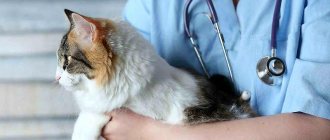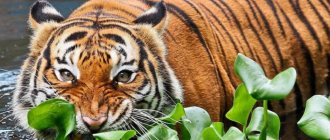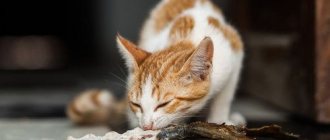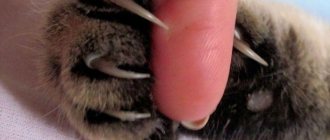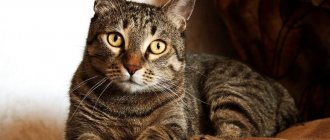Dune cat | Speed up to 40 km/h
The sand cat opens the top 10 fastest cats in the world. Over short distances, the small predator is capable of accelerating up to 40 km/h while pursuing prey. The animal usually moves quickly, in rapid bursts, and covers up to 10 km per day. Due to its small size, the sand cat has enemies among birds of prey and jackals. Therefore, she has to not only search for food, but also constantly be on alert so as not to suffer from other carnivorous animals.
Summarizing
Even the slowest domestic cats can reach impressive speeds of up to 30 km per hour! Some cats would rather not waste their days so quickly, but trust us, if they have to, they are more than capable.
Other cats that are active and spend most of the day playing can easily reach a top speed of about 50 km per hour. Considering that this is the same speed as the world record for a human sprinter, this is impressive.
This is all because of the cat's incredibly powerful hind legs and flexible spines. So, the next time your indoor cat curls up next to you, take a moment to appreciate the incredible anatomy that allows them to run so fast.
Posted by Emma Stenhouse Emma is a freelance writer specializing in pets, outdoor activities and the environment. Originally from the UK, she lived in Costa Rica and New Zealand before moving to a small holding in Spain with her husband, their 4-year-old daughter and their dogs, cats, horses and birds.
Egyptian Mau | Speed up to 58 km/h
The Egyptian Mau is the fastest non-wild cat in the world. The maximum record that this miniature beauty is capable of is 58 km/h over short distances. If the Egyptian woman had the size of a cheetah, then she could easily compete with him in the speed of movement. The speed champion is the owner of an elegant, flexible and muscular body, the weight of which ranges from 3 to 6 kg depending on gender. Translated from Egyptian, "mau" means cat. In Egypt, this animal was considered sacred and was personified with the moon goddess.
Top 10 dangerous breeds
In addition to peaceful and friendly cat breeds, there are also those that are endowed with a willful and cocky disposition.
Such pets are poorly adapted to living together with people and, under certain circumstances, become very aggressive and unsafe. When enraged, these cats can cause no less harm than a poisonous spider or an angry dog. The list of the 10 most dangerous breeds includes:
- savannah;
- manul;
- Abyssinians;
- Siamese;
- Maine Coon;
- British;
- Siberian;
- Bengali;
- chausie;
- reed
Savannah
These large graceful animals are considered one of the most dangerous cats in the world. Although Savannahs can be tamed, there is always a risk that they will become aggressive.
The owners of these cats must always be on alert, because their graceful pets often perceive strangers as objects of hunting.
Manul
This wild feline is similar to a lynx and is completely untamed. Even a manul raised in captivity will avoid people. These aggressive and dangerous cats are not suitable for home keeping.
No matter how hard you try, it is impossible to teach wild Pallas’ cats commands and stop them from damaging their owner’s property.
Abyssinians
These sophisticated oriental beauties also belong to the category of dangerous cats. It turns out that representatives of the breed are very vindictive and immediately take revenge for insults inflicted on them. Without proper attention, Abyssinians become wild and aggressive.
Siamese
These cunning and dangerous cats are very aggressive and vindictive. They can harbor a grudge for a long time and take revenge at the most unexpected moment. Siamese cats do not like excessive attention and do not tolerate familiarity. It is not advisable to take representatives of the breed into families with children.
These cats pose a real danger to children who do not yet know how to properly handle a pet.
Maine Coon
These smart and flexible animals are endowed with a changeable disposition and can begin to take revenge even for a minor offense. Large and dangerous Maine Coon cats cannot stand loneliness and, due to their size, are capable of crippling a person.
British
This cute domestic cat is endowed with an independent and willful character. The proud and freedom-loving Briton has no love for strangers and prefers to distance himself from them. He can hardly tolerate being picked up or forced to play.
Siberian
This large and quite dangerous cat is wary of strangers and can only get along with someone who has a highly developed sense of self-esteem.
An independent and strong Siberian can be both affectionate and sensitive, and aggressive. To smooth out developed hunting instincts and avoid unwanted behavior, this cat must be trained from an early age.
Bengal
This impulsive and dangerous cat has highly developed hunting instincts. To prevent a Bengal kitten from becoming an aggressive monster, it is raised in a calm atmosphere.
An active and mobile animal does not like to be forcibly held in arms and does not tolerate being addressed in a raised voice. An angry Bengal cat can be unsafe and capable of causing serious damage.
Chausie
These powerful animals, more like a puma, also belong to the category of aggressive and unsafe breeds. Aggressive cats need to be dealt with constantly and dangerous games should not be played.
Chausies have developed hunting instincts, do not tolerate confined spaces and are not suitable for apartment living.
Reed
This aggressive and dangerous cat with the appearance of a lynx is practically impossible to domesticate and is difficult to train. She needs constant communication, and if there is a lack of it, she quickly runs wild.
Tiger | Speed up to 60 km/h
The tiger is one of the fastest felines in the world. Over short distances, the cat can reach speeds of up to 60 km/h. While chasing prey, they jump up to six meters in length and up to five meters in height. But despite this ability, only one hunt out of ten attempts ends in success. Tigers are quite heavy predators with a body weight of up to 300 kg and a body length without a tail of up to three meters. This is one of the reasons why their speed is significantly less than that of a lean cheetah.
The lion is the only social feline
Photo: Neil Midlane/Panthera Male lions rarely take part in hunting, but they earn their right to kill by protecting the pride.
Photo: Nick Garbutt/Panthera All females in a pride care for their cubs, regardless of which one is the biological mother.
- Members of a pride of lions show touching tenderness to each other on vacation, and during the hunt they act as a well-coordinated team to repel the prey from the herd.
- If conditions are favorable and food is plentiful, female lions can remain in a pride for the rest of their lives. But the males, having reached sexual maturity, leave the family, forced out by the dominant tribesman. Such loners sometimes form “teenage gangs” and roam the savannah in the hope of creating their own pride, which they will protect from strangers.
- The terrifying roar of a lion can be heard at a distance of five kilometers.
- Lions and tigers are very close species, anatomically extremely similar to each other. By looking at their skeletons, only experts will be able to determine which is a lion and which is a tiger.
- Since the 1950s, the lion population has declined by half, and the big cats are now gone from 80% of their historical range. According to the latest data, less than 30 thousand lions live in Africa today.
Puma | Speed up to 75 km/h
The Puma is ranked sixth in the list of the fastest cats on the planet. The predator is capable of making a powerful sprint over short distances at speeds of up to 75 km/h. The second name common in America is mountain lion. This is a fairly large animal, which, together with its tail, reaches two meters in length. Weight, depending on gender and individual physiology, ranges from 50-100 kg. For a cat of this size, this is not so much. A muscular body and light weight help the mountain lion to be agile and fast.
Somalia
The Somali cat is a long-haired version of the Abyssinian. These animals have impressive athletic abilities that not everyone can see. In addition, they have a muscular body and large, strong paws. These cats are not averse to learning new tricks. They have a need for constant physical activity. Therefore, their owners must constantly maintain the animal’s physical condition by organizing a variety of training sessions. The training can also be a regular game, involving various toys, from which they are extremely delighted.
Snow leopard | Speed up to 80 km/h
The fifth place in the ranking of the fastest cats in the world is occupied by the snow leopard . Otherwise it is called the snow leopard, which means “snow cat.” This rare and beautiful feline species is capable of reaching speeds of up to 80 km/h for short distances. The peculiarity of the animal is its six-meter long jumps and three-meter high jumps. Leopards have short, but very powerful, muscular legs and a long tail, which acts as a rudder when running at high speed. Together with the tail, individuals can reach a length of up to 2.3 meters, but they weigh quite little: up to 55 kg. The snow leopard is considered the highest mountain animal on the planet. The maximum altitude at which a snow leopard has been recorded is 6 kilometers above sea level.
Description of appearance
Jaguars belong to a species of predatory mammals of the cat family. These animals are the largest predators living on the American continent. Among the largest representatives of predatory animals they occupy an honorable third place.
The body of some animals can reach a length of 2 meters. Such specimens are found in the jungles of Brazil. The average weight of a jaguar is 80-90 kg, but there are animals whose weight exceeds 100 kg. Outwardly, they are very similar to leopards, but much larger in size. Males are larger in weight and size than females.
The height at the withers of the predator reaches 80 cm, and the length of the tail is 50-80 cm. This strong, large and agile animal has a smooth-haired skin. The fur is short and the head has rounded ears. The structure of the skull is very similar to tigers. The color of the animal can be very diverse. Typically, the coat color is dominated by shades of rich red and sandy tones. The lower part of the body and soles are white. The entire body is decorated with dark spots.
These cats have well-developed all senses:
- amazing hearing;
- sharp vision.
The jaguar's whiskers are the main organ of touch. Thanks to this, the animal moves almost silently at night in the jungle.
The black jaguar is also common in nature. In appearance, this cat is one of the most beautiful in this family. The weight of a black jaguar can reach 120 kg, and the length of its tail is up to 1 meter. It fascinates with its beauty, so local residents believe that the black jaguar is endowed with hypnosis. These jaguar cats are often confused with panthers. They prefer wild spaces. The panther jaguar loves to live in tropical forests.
Leo | Speed up to 80 km/h
Leo ranks fourth in the top ten fastest cats. At a distance of 20 meters, the giant kitty can maintain a run of 80 km/h. While chasing its prey, a lion can maintain a speed of up to 60 km/h for the next hundred meters. These are quite heavy animals. The weight of some individuals can reach 250 kilograms, so it is very difficult for them to maintain their speed record for a long time. Because of this, lions hunt at short distances, trying to sneak up on their prey as unnoticed as possible. Usually the hunter overtakes his prey with a lightning-fast jump.
Cougars are masters at hiding; it is very difficult to notice this big cat in nature.
Photo: Brad Boner/Panthera
Photo: Mark Elbroch/Panthera Pumas usually give birth to two to four cubs, which remain with their mother until they are 1.5 to 2 years old.
- This species claims to be in the Guinness Book of Records for the number of names, only in English - there are about forty of them. The cougar has been called a mountain lion, bobcat, ghost cat, panther, and even a mountain screamer.
- Cougars can't roar. Instead, they make chirping or drawn-out howl-like sounds and, of course... an affectionate purr.
- Cougars hunt from ambush, often bringing their prey within range of a single, but powerful and accurate jump. Thanks to these tactics, these animals developed extraordinary abilities. In one jump, a puma can jump 4.5 meters up from a place, and when jumping on prey, especially from a hill, it can cover a distance of 12.5 meters.
- It’s not for nothing that they say: if there’s no fish, there’s only cancer. The main prey of pumas are deer, but if there is a shortage of them, then wild cats are content with everything that is edible, including insects. It seems that when catching the latter, no less dexterity is needed.
- The population of pumas in the world is quite stable, and only the subspecies living in Florida (North America) now numbers only about a hundred individuals.
Black Panther | Speed up to 88 km/h
The black panther opens the top three fastest felines. The maximum recorded speed that a cat can accelerate to is 88 km/h. In addition to speed, panthers also stand out because they are considered the most dangerous predators on the planet. They are very bloodthirsty, and when hungry they can attack any living creature, including humans. The animal is inherently fearless: unlike other predators, they are not used to hiding when they see people. On the contrary, the panther tries to settle as close to human habitation as possible. Not a single case of attack on a person is known.
What does a liger eat?
Photo: Liger cat
The liger eats a lot of meat, so the costs of keeping it in zoos are enormous. To maintain the genetic potential of a predator, ligers are regularly introduced to live prey so that the cats can hunt and learn the nuances of wild life. In general, a liger eats from 10 to 15 kg of meat, depending on its gender, age and size.
The following “dishes” are most often served to ligers:
- chickens, including live ones, which ligers kill on their own;
- rabbits, also sometimes live;
- processed beef meat, offal, heads and hooves with hard bones for ligers to wear down their teeth;
- eggs, in particular - white, crushed with shell;
- fat milk.
Ligers do not refuse raw fish and play with it with pleasure. Also, large cats are often offered watermelons: they play with them and, in the end, bite them. Plant food is included in the daily diet of ligers. They are given all kinds of vitamin mixtures to keep the big cats healthy. Such mixtures are especially important for babies, who need to strengthen the skeleton and prevent possible diseases.
There is always a lot of fresh growing grass in the liger's enclosure. Big cats often lie among tall grass and bite it - this indicates the need for vitamins in the body of a big cat. They are offered peaches, apricots, tomatoes, cucumbers, lettuce and many other fruits and vegetables as natural vitamins.
Features of character and lifestyle
Photo: Hybrid liger
The character of ligers can be called versatile. These cats have inherited behavioral traits from both their lion father and tiger mother. From lions, ligers adopted a love for social groups. Lions have a very positive attitude towards all big cats. They easily get along with each other and fit into prides of lions. In relation to other cats, ligers are non-confrontational, love affection, and strive to be close to other relatives.
On the other hand, ligers have adopted from tigers the tendency to mark territory and defend it. The liger has a flock, which he perceives as family, but he also has his own corner, which belongs only to him. Female ligers are especially prone to this, just like tigresses do. Also, from tigers, ligers inherited a love of water and swimming. They willingly frolic in ponds, drag prey there, dive and simply lie in the water - lions have a dislike for water and even fear of bodies of water.
The liger is also similar to the tiger in that it can easily withstand low temperatures. Tigers are adapted to cold weather - their fur is known for its dense undercoat, which the tigress passed on to their children - the ligers. At the same time, ligers do not suffer from heat, since their fur provides competent thermoregulation. In severe frosts, ligers happily roll around in the snow, and in hot weather they lie in the water.
Social structure and reproduction
Photo: Liger cubs
Male ligers are absolutely sterile, but females have a chance of having offspring, although it is very low
This does not negate the fact that female ligers have a period of estrus, during which they show increased attention to males of all species: ligers, tigers and lions. A ligress can only have offspring from lions. In search of a partner, a female liger is even able to climb over the high fence separating her from the enclosure with other large cats.
Regardless of whether she ends up with a tiger or a lion, the female’s behavior will be the same.
A ligress in heat marks her territory, letting the males know that she is ready to mate. In zoo conditions, keepers do not allow any exhibition tournaments between male tigers or lions, so the female, as a rule, does not choose a partner for herself - he is simply released into her enclosure. Big cats have very beautiful foreplay. They affectionately rub their heads against each other, lie next to each other for a long time and lick each other's fur. For lions, such foreplay is faster, but for tigers it can last more than a day. After mating, the female and male separate.
Pregnancy lasts about 110 days. As a result, the female gives birth to one or two cubs, and most often these are the same infertile males. The descendants of a lion and a ligress are called liligers, and this is an extremely rare case when the offspring are born alive and healthy. As a rule, cubs do not survive until three months. In theory, female liligers could have offspring with lions, but lions have a strong genetic potential, which is why the resulting offspring will not resemble ligers - they will be ordinary lion cubs. Often, female ligers do not have milk, which is why zookeepers feed their offspring.
Jaguar | Speed up to 90 km/h
the Jaguar ranks second in the ranking of the fastest cats in the world. The predator is able to maintain maximum speed only for a short period of time while pursuing prey. Another feature of this giant cat is its ability to jump more than 6 meters. The jaguar is a large animal whose body length can reach almost 2 meters without a tail. Outwardly, it resembles a leopard, but is much larger.
Cheetah | Speed up to 112 km/h
The cheetah is the fastest cat, possessing not only the fastest speed of any feline, but of all animals in the world! In just three seconds, a cheetah can run up to 112 km/h. The maximum take-off run over short distances is 130 km/h. He has a slender, graceful body and well-developed muscles. The large predator has practically no fat layer, and its weight, despite its dimensions, reaches a maximum of only 65 kilograms. It is his aerodynamic body structure that allows him to develop such speed. During the maximum run, this predator’s breathing rate develops up to 150 times per minute. In addition, the cheetah is able to change the direction of its run with lightning speed. Thus, the hunter's prey has virtually no chance of survival.
123 9



